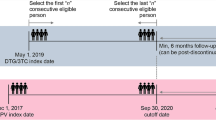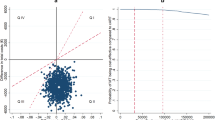Abstract
Background: Very few studies have evaluated the cost of highly active antiretroviral therapy (HAART) per successful treatment in HIV-infected patients.
Objectives: To evaluate the cost of achieving undetectable plasma HIV-RNA levels in highly treatment-experienced, HIV-1-infected adults receiving darunavir/ritonavir (DRV/r 600 mg/100mg twice a day) or control protease inhibitor (PI)-based HAART.
Methods: The mean annual per-patient cost of DRV/r and control PI-based HAART was determined from the proportional use of antiretroviral agents in the DRV/r and control PI arms of the pooled POWER 1 and 2 trials, applying drug acquisition costs for 13 healthcare settings. The mean annual cost per patient of achieving undetectable plasma HIV-RNA levels (<50 copies/mL) was calculated by dividing the cost of each treatment by the proportion of patients with undetectable plasma HIV-RNA levels after 48 weeks in the DRV/r (45%) and control PI (10%) arms of the POWER trials.
Results: Whereas absolute costs of treatment were 1–19% higher with DRV/r versus control PI-based HAART depending on the healthcare setting, the mean annual per-patient cost of achieving undetectable plasma HIV-RNA levels was 73–78%lower. These cost savings were maintained in the sensitivity analyses, adjusting for control PI and enfuvirtide use, and the number of active drugs in the background regimen. The incremental annual cost per additional patient achieving undetectable plasma HIV-RNA levels with DRV/r versus control PI-based HAART in POWER 1 and 2 (d4148) compared favourably with that determined for enfuvirtide (d137 740; TORO trials) and tipranavir/ritonavir (d32 176; RESIST) versus control therapy.
Conclusions: DRV/r-based HAART provided consistent reductions in the cost of achieving undetectable plasma HIV-RNA levels compared with control PI-based therapy in highly treatment-experienced patients across various healthcare settings. The incremental cost per additional patient achieving undetectable plasma HIV-RNA levels with DRV/r versus control PI-based HAART was also lower than that calculated for other treatment options in this population. These results suggest that DRV/r is an economically viable option for highly treatment-experienced patients.









Similar content being viewed by others
References
Gazzard B, on behalf of the BHIVA Writing Committee. British HIV Association guidelines for the treatment of HIV-1-infected adults with antiretroviral therapy 2008. HIV Med 2008; 9: 563–608
Thompson MA, Aberg JA, Cahn P, et al. Antiretroviral treatment of adult HIV infection: 2010 recommendations of the International AIDS Society’ USA panel. JAMA 2010; 304: 321–33
Hill A, Miralles D, Vangeneugden T, et al. Should we now adopt the HIV-RNA <50 copy endpoint for clinical trials of antiretroviral-experienced as well as naive patients? AIDS 2007; 21: 1651–3
Bracciale L, Di Giambenedetto S, Colafigli M, et al. Virological suppression reduces clinical progression in patients with multiclass-resistant HIV type 1. AIDS Res Hum Retroviruses 2009; 25: 261–7
Olsen CH, Gatell J, Ledergerber B, et al. Risk of AIDS and death at given HIV-RNA and CD4 cell counts, in relation to specific antiretroviral drugs in the regimen. AIDS 2005; 19: 319–30
MacArthur RD, Perez G, Walmsley S, et al. Comparison of prognostic importance of latest CD4+ cell count and HIV RNA levels in patients with advanced HIV infection on highly active antiretroviral therapy. HIV Clin Trials 2005; 6: 127–35
Bartlett JA, Fath MJ, DeMasi R, et al. An updated systematic overview of triple combination therapy in antiretroviral-naive HIV-infected adults. AIDS 2006; 20: 2051–64
Mocroft A, Ledergerber B, Viard JP, et al. Time to virological failure of 3 classes of anti-retrovirals after initiation of highly active antiretroviral therapy: results from the Euro SIDA study group. J Infect Dis 2004; 190: 1947–56
Sabin CA, Scullard G, Easterbrook P, et al. Treatment exhaustion of highly active antiretroviral therapy (HAART) among individuals infected with HIV in the United Kingdom: multicentre cohort study. BMJ 2005; 330: 695–9
Murray JS, Elashoff MR, Iacono-Connors LC, et al. The use of plasma HIV RNA as a study endpoint in efficacy trials of antiretroviral drugs. AIDS 1999; 13: 797–804
Basu RP, Grimes RM, Helmy A. Cost to achieve an undetectable viral load using recommended antiretroviral regimens. HIV Clin Trials 2006; 7: 309–18
Ruof J, Dusek A, DeSpirito M, et al. Cost-efficacy comparison among three antiretroviral regimens in HIV-1 infected, treatment-experienced patients. Clin Drug Invest 2007; 27: 469–79
Mills AM, Nelson M, Jayaweera D, et al. Once-daily darunavir/ritonavir vs. lopinavir/ritonavir in treatment-naive, HIV-1-infected patients: 96-week analysis. AIDS 2009; 23: 1679–88
Madruga JV, Berger D, McMurchie M, et al. Efficacy and safety of darunavirritonavir compared with that of lopinavir ritonavir at 48 weeks in treatment-experienced, HIV infected patients in TITAN: a randomised controlled phase III trial. Lancet 2007; 370: 49–58
Clotet B, Bellos N, Molina JM, et al. Efficacy and safety of darunavirritonavir at week 48 in treatment-experienced patients with HIV-1 infection in POWER 1 and 2: a pooled subgroup analysis of data from two randomised trials. Lancet 2007; 369: 1169–78
European AIDS Clinical Society (EACS). Guidelines for the clinical management and treatment of HIV infected adults in Europe; 2009 Nov [online]. Available from URL: (http://www.europeanaidsclinicalsociety.org/guidelines.asp) [Accessed 2010 Aug 25]
Kaletra® (lopinavir/ritonavir tablets). Abbott Laboratories. US Prescribing Information; 2009 Oct [online]. Available from URL: (http://www.rxabbott.com/pdf/kaletratabpi.pdf) [Accessed 2010 Aug 25]
Nelson M, Fatkenheuer G, Konourina I, et al. Efficacy and safety of maraviroc plus optimized background in viremic, ART-experienced patients infected with CCR5-tropic HIV-1 in Europe, Australia, and North America: 24-week results [abstract 104aLB]. 14th Conference on Retroviruses and Opportunistic Infections; 2007 Feb 2528; Los Angeles, CA, USA
Hicks C, Cahn P, Cooper DA, et al. Durable efficacy of tipranavirritonavir in combination with an optimised background regimen of antiretroviral drugs for treatmentexperienced HIV-1-infected patients at 48 weeks in the Randomized Evaluation of Strategic Intervention in multidrug resistant patients with Tipranavir (RESIST) studies: an analysis of combined data from two randomised openlabel trials. Lancet 2006; 368: 466–75
Lazzarin A, Quelroz-Telles F, Rockstroh J, et al. TMC114/r provides durable viral load suppression in treatment experienced patients: POWER 1 and 2 combined week 48 analysis [abstract TUAB0104]. 16th International AIDS Conference; 2006 Aug 1318; Toronto, Canada
Lazzarin A, Clotet B, Cooper D, et al. Efficacy of enfuvirtide in patients infected with drug-resistant human immunodeficiency virus type 1 in Europe and Australia. N Engl J Med 2003; 348: 2186–95
Lalezari JP, Henry K, O’Hearn M, et al. Enfuvirtide, an HIV-1 fusion inhibitor, for drug-resistant HIV infection in North and South America. N Engl J Med 2003; 348: 2175–85
Hill A, Moyle G. Relative antiviral efficacy of ritonavirboosted DRV and ritonavir-boosted tipranavir vs. control protease inhibitor in the POWER and RESIST trials. HIV Med 2007; 8: 259–64
Cahn P, Villacian J, Lazzarin A, et al. Ritonavir-boosted tipranavir demonstrates superior efficacy to ritonavirboosted protease inhibitors in treatment-experienced HIV infected patients: 24-week results of the RESIST-2 trial. Clin Infect Dis 2006; 43: 1347–56
Gathe J, Cooper DA, Farthing C, et al. Efficacy of the protease inhibitors tipranavir plus ritonavir in treatmentexperienced patients: 24-week analysis from the RESIST-1 trial. Clin Infect Dis 2006; 43: 1337–46
Moore RD, Keruly JC, Gebo KA, et al. An improvement in virologic response to highly active antiretroviral therapy in clinical practice from 1996 through 2002. J Acquir Immune Defic Syndr 2005; 39: 195–8
Ammassari A, Trotta MP, Murri R, et al. Correlates and predictors of adherence to highly active antiretroviral therapy: overview of published literature. J Acquir Immune Defic Syndr 2002; 31 (Suppl. 3): S123–7
Freedberg KA, Losina E, Weinstein MC, et al. The cost effectiveness of combination antiretroviral therapy for HIV disease. N Engl J Med 2001; 344: 824–31
Chancellor JV, Hill AM, Sabin CA, et al. Modelling the cost-effectiveness of lamivudine/zidovudine combination therapy in HIV infection. PharmacoEconomics 1997; 12: 54–66
Hornberger J, Kilby JM, Wintfeld N, et al. Cost effectiveness of enfuvirtide in HIV therapy for treatmentexperienced patients in the United States. AIDS Res Hum Retroviruses 2006; 22: 240–7
Pozniak A, Jayaweera D, Hoy J, et al. Efficacy of DRV/ritonavir in treatment-experienced HIV-1-infected patients at 96 weeks in the POWER 1 and 2 trials [abstract P7.2/07]. 11th European AIDS Conference; 2007 Oct 2427; Madrid, Spain
Levy AR, James D, Johnston KM, et al. The direct costs of HIV/AIDS care. Lancet Infect Dis 2006; 6: 171–7
De Meyer SM, Spinosa-Guzman S, Vangeneugden TJ, et al. Efficacy of once-daily darunavir/ritonavir 800/100 mg in HIV-infected, treatment-experienced patients with no baseline resistance-associated mutations to darunavir. J Acquir Immune Defic Syndr 2008; 49: 179–82
Ortiz R, Dejesus E, Khanlou H, et al. Efficacy and safety of once-daily darunavir/ritonavir versus lopinavir/ritonavir in treatment-naive HIV-1-infected patients at week 48. AIDS 2008; 22: 1389–97
Acknowledgements
The authors would like to thank Tony Vangeneugden, Ben Van Baelen, Eric Lefebvre, Sabrina Spinosa-Guzman, Piet De Doncker and other members of the darunavir study team for their contributions. The authors also acknowledge Patrick Hoggard (medical writer, Gardiner-Caldwell Communications, Macclesfield, UK) for his editorial support. Finally, they wish to thank the investigators and the patients and their families for their participation and support during the POWER studies. This project was financially supported by Johnson & Johnson Pharmaceutical Services.
AMH has received consultancy payments from Tibotec to work on the health economics of darunavir. BC has served as a consultant on advisory boards, participated in speakers’ bureaux or conducted clinical trials with Roche, Boehringer-Ingelheim, Abbott, Bristol-Myers Squibb, GlaxoSmithKline, Gilead, Tibotec, Janssen, Merck, Pfizer, Siemens, Monogram Biosciences and Panacos. MJ has received consultancy fees and honoraria from GlaxoSmithKline, Boehringer-Ingelheim, Gilead Sciences, Roche Pharmaceuticals, Merck Sharp and Dohme, Bristol-Myers Squibb and Abbott Laboratories. MS has received honoraria for attending advisory boards and has received honoraria as a speaker on scientific boards. ES is an employee of Johnson & Johnson Pharmaceutical Services, Beerse, Belgium, and owns stock options and shares in this company.
Author information
Authors and Affiliations
Corresponding author
Rights and permissions
About this article
Cite this article
Hill, A.M., Clotet, B., Johnson, M. et al. Costs to Achieve Undetectable HIV RNA with Darunavir-Containing Highly Active Antiretroviral Therapy in Highly Pretreated Patients. Pharmacoeconomics 28 (Suppl 1), 69–81 (2010). https://doi.org/10.2165/11587460-000000000-00000
Published:
Issue Date:
DOI: https://doi.org/10.2165/11587460-000000000-00000




